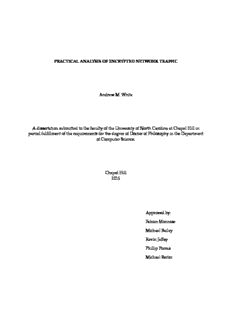
PRACTICAL ANALYSIS OF ENCRYPTED NETWORK TRAFFIC Andrew M. White A dissertation ... PDF
Preview PRACTICAL ANALYSIS OF ENCRYPTED NETWORK TRAFFIC Andrew M. White A dissertation ...
PRACTICALANALYSISOFENCRYPTEDNETWORKTRAFFIC AndrewM.White AdissertationsubmittedtothefacultyoftheUniversityofNorthCarolinaatChapelHillin partialfulfillmentoftherequirementsforthedegreeofDoctorofPhilosophyintheDepartment ofComputerScience. ChapelHill 2015 Approvedby: FabianMonrose MichaelBailey KevinJeffay PhillipPorras MichaelReiter ©2015 AndrewM.White ALLRIGHTSRESERVED ii ABSTRACT AndrewM.White: PRACTICALANALYSISOFENCRYPTEDNETWORKTRAFFIC (UnderthedirectionofFabianMonrose) Thegrowinguseofencryptioninnetworkcommunicationsisanundoubtedboonforuser privacy. However,thelimitationsofreal-worldencryptionschemesarestillnotwellunderstood, andnewside-channelattacksagainstencryptedcommunicationsaredisclosedeveryyear. Furthermore,encryptednetworkcommunications,bypreventinginspectionofpacketcontents, representasignificantchallengefromanetworksecurityperspective: ourexistinginfrastructure reliesonsuchinspectionforthreatdetection. Bothproblemsareexacerbatedbytheincreasing prevalenceofencryptedtraffic: recentestimatessuggestthat65%ormoreofdownstream Internettrafficwillbeencryptedbytheendof2016. Thisworkaddressestheseproblemsby expandingourunderstandingofthepropertiesandcharacteristicsofencryptednetworktraffic andexploringnew,specializedtechniquesforthehandlingofencryptedtrafficbynetwork monitoringsystems. Wefirstdemonstratethatopaquetraffic,ofwhichencryptedtrafficisasubset,canbe identifiedinreal-timeandhowthisabilitycanbeleveragedtoimprovethecapabilitiesofexisting IDSsystems. Todoso,weevaluateandcomparemultiplemethodsforrapididentificationof opaquepackets,ultimatelypinpointingasimplehypothesistest(whichcanbeimplementedon anFPGA)asanefficientandeffectivedetectorofsuchtraffic. Inourexperiments,usingthis techniqueto“winnow”,orfilter,opaquepacketsfromthetrafficloadpresentedtoanIDSsystem significantlyincreasedthethroughputofthesystem,allowingtheidentificationofmanymore potentialthreatsthanthesamesystemwithoutwinnowing. Second,weshowthatsidechannelsinencryptedVoIPtrafficenablethereconstructionof approximatetranscriptsofconversations. Ourapproachleveragestechniquesfromlinguistics, machinelearning,naturallanguageprocessing,andmachinetranslationtoaccomplishthistask despitethelimitedinformationleakedbysuchsidechannels. Ourabilitytodosounderscores iii boththepotentialthreattouserprivacywhichsuchsidechannelsrepresentandthedegreeto whichthisthreathasbeenunderestimated. Finally,weproposeanddemonstratetheeffectivenessofanewparadigmforidentifying HTTPresourcesretrievedoverencryptedconnections. Ourexperimentsdemonstratehowthe predominantparadigmfrompriorworkfailstoaccuratelyrepresentreal-worldsituationsand howourproposedapproachofferssignificantadvantages,includingtheabilitytoinferpartial information,incomparison. Webelievetheseresultsrepresentbothanenhancedthreattouser privacyandanopportunityfornetworkmonitorsandanalyststoimprovetheirowncapabilities withrespecttoencryptedtraffic. iv ACKNOWLEDGEMENTS Ihavebeenfortunatetoreceiveaidandencouragementfromagreatnumberofpeopleover thepastsevenyears. Firstandforemost,IwouldliketothankStephanieMalone,aswellasmy parentsandfamily,fortheirsupportandunderstanding. Second,Icannotadequatelyexpressmy gratitudetoProf.FabianMonrose,whohasbeenamentorandcolleaguethroughoutandwho hassupportedmeintoomanywaystocountsinceourfirstdaysatUNC. Iwouldalsoliketothanktheremainderofmycommittee(Prof.MichaelBailey,Prof.Michael Reiter,Prof.KevinJeffay,andPhilPorras)fortheiradviceandtheirtime. Specialthanksarealso duetomycolleaguesandcollaboratorsatUNC(particularlyProf.Jan-MichaelFrahm,Srinivas Krishnan,AustinMatthews,Prof.ElliottMoreton,NathanOtternes,RahulRaguram,Katherine Shaw,KevinSnow,TerylTaylor,JanWerner,andYiXu);atSRIInternational(particularlyVinod Yegneswaran);andatIBMResearch(particularlyReinerSailer,MihaiChristodorescu,andMarc Stoecklin). Inaddition,MurrayAnderegg,JakeCzyz,AlexEverett,JimGogan,BilHays,Jodie Turnbull,andMissyWoodprovidedinvaluableassistanceduringthecourseofthiswork. Finally,IwouldliketoexpressmyeternalgratitudetoToddAnderson,BrianCollier,and DavidFortney,forkeepingmeoffthewrongpath,andtoProf.BarryLawson,Prof.Douglas Szajda,andProf.JasonOwen,forhelpingmefindtherightone. ThisworkwassupportedinpartbytheDepartmentofHomelandSecurity(DHS)under contractnumberD08PC75388,theU.S.ArmyResearchOffice(ARO)underCyber-TAGrantno. W911NF-06-1-0316,andtheNationalScienceFoundation(NSF)underawardno. 0831245. Any opinions,findings,andconclusionsorrecommendationsexpressedinthismaterialarethoseof theauthorsanddonotnecessarilyreflecttheviewsoftheDHS,NSF,orARO. v TABLEOFCONTENTS LISTOFTABLES ...................................................................... xii LISTOFFIGURES ..................................................................... xiii LISTOFABBREVIATIONS ............................................................. xv CHAPTER1 INTRODUCTION........................................................ 1 ThesisStatement ........................................................ 4 1.1 Real-timeDetectionofOpaqueNetworkTraffic .................................. 5 1.2 ReconstructingTranscriptsofEncryptedVoIPConversations ...................... 6 1.3 IdentificationofEncryptedWebResources....................................... 7 1.4 Contributions ................................................................. 8 CHAPTER2 OPAQUETRAFFIC ...................................................... 10 2.1 Introduction................................................................... 10 2.2 Approach ..................................................................... 13 LikelihoodRatioTest .................................................... 15 SequentialProbabilityRatioTest ......................................... 15 2.3 Evaluation .................................................................... 16 2.3.1 OfflineAnalysis......................................................... 17 FileTypeIdentification .................................................. 17 ContentTypeMatching.................................................. 18 OperatorAnalysis....................................................... 23 2.3.2 OnlineAnalysis......................................................... 25 vi OperationalImpact ..................................................... 30 2.4 Limitations.................................................................... 31 2.5 RelatedWork.................................................................. 32 2.6 Discussion .................................................................... 34 2.7 FutureWork................................................................... 35 CompressedvsEncrypted......................................... 35 Flow-levelAnalysis ............................................... 35 2.8 BroaderImplications........................................................... 35 CHAPTER3 PHONOTACTICRECONSTRUCTIONOFENCRYPTEDVOIPCONVERSA- TIONS .................................................................. 37 3.1 Introduction................................................................... 37 3.2 BackgroundInformation ....................................................... 39 3.2.1 PhoneticModelsofSpeech .............................................. 39 3.2.2 VoiceoverIP ........................................................... 41 3.3 OverviewofOurApproach..................................................... 42 3.3.1 DataandAdversarialAssumptions....................................... 44 3.4 RelatedWork.................................................................. 45 3.5 Methodology.................................................................. 46 3.5.1 FindingPhonemeBoundaries(Stage➊)................................... 47 3.5.2 Methodology ........................................................... 47 3.5.3 Evaluation.............................................................. 50 3.5.4 ClassifyingPhonemes(Stage➋).......................................... 52 3.5.5 MaximumEntropyDiscriminationofPhonemes........................... 53 3.5.6 HMMModelingofPhonemes............................................ 54 3.5.7 Classification ........................................................... 55 vii 3.5.8 EnhancingClassificationusingLanguageModeling ....................... 55 3.5.9 Evaluation.............................................................. 55 3.5.10 SegmentingPhonemeStreamsintoWords(Stage➌) ....................... 56 3.5.11 IdentifyingWordsviaPhoneticEditDistance(Stage➍) .................... 57 3.5.12 MeasuringtheQualityofOurOutput .................................... 61 3.6 EmpiricalEvaluation........................................................... 64 3.6.1 AnAdversarialPointofView(MeasuringConfidence) ..................... 66 3.6.2 Discussion&Mitigation ................................................. 68 3.7 Conclusion.................................................................... 69 3.8 FutureWork................................................................... 70 Skype............................................................ 70 ConversationalSpeech ............................................ 70 3.9 BroaderImplications........................................................... 70 CHAPTER4 PLAYINGHIDE-AND-SEEK.............................................. 72 4.1 Introduction................................................................... 72 4.2 Background&RelatedWork.................................................... 76 4.2.1 LearningAlgorithms .................................................... 78 4.2.2 Features................................................................ 78 4.3 AssumptionsandThreatModel................................................. 79 4.3.1 NetworkingModel...................................................... 79 4.3.2 EncryptionModel....................................................... 80 HTTPSmodel .................................................... 80 TunnelModel .................................................... 81 DNSTraffic............................................................. 81 viii 4.3.3 WorldModels .......................................................... 82 Closed-world..................................................... 82 Open-world ...................................................... 82 BinaryOpen-world ........................................... 83 PartialInformation ............................................... 83 4.4 Approach ..................................................................... 84 4.4.1 ClassificationScheme: Multi-label........................................ 84 4.4.2 ClassifierModel: RandomForest ......................................... 85 SupportVectorMachineClassifiers....................................... 85 NaïveBayesClassifiers .................................................. 86 RandomForests......................................................... 87 SuitabilityforOurApproach............................................. 88 4.4.3 AbstentionandThresholding ............................................ 89 Post-ClassificationThresholding ......................................... 90 ValidationandThresholdSelection ....................................... 91 4.4.4 Hyper-parameterOptimization .......................................... 91 4.4.5 EpochValidation........................................................ 93 4.5 Evaluation .................................................................... 93 4.5.1 DataCollection ......................................................... 93 URLs .................................................................. 94 ScriptedRetrievals ...................................................... 95 4.5.2 EvaluationCriteria...................................................... 96 Multi-classMetrics...................................................... 96 Multi-labelMetrics...................................................... 97 ix 4.5.3 ExperimentalSetup ..................................................... 98 WorldModels .................................................... 98 Datasets ......................................................... 99 LearningAlgorithms.............................................. 100 Multi-labelClassification...................................... 100 FeatureSets ...................................................... 101 ValidationandDataSelection...................................... 101 Hyper-parameterOptimization .................................... 101 4.5.4 Implementation......................................................... 104 4.5.5 Results ................................................................. 104 Multi-classComparisonwithPreviousWork .............................. 104 MultipleURLsperDomainName ........................................ 106 Hyper-parameterOptimization .................................... 108 LabelingTraceswithURLComponents................................... 110 AbstainingfromClassification ........................................... 111 SummaryofFindings ................................................... 112 4.5.6 LimitationsandFutureWork ............................................ 114 4.6 BroaderImplications........................................................... 115 CHAPTER5 DISCUSSION&CONCLUSIONS ......................................... 116 A OPAQUETRAFFIC ................................................................. 117 A.1 ComparisonofMethods........................................................ 117 A.1.1 Preliminaries ........................................................... 117 DiscreteKolmogorov-SmirnovTest ....................................... 118 A.1.2 ParameterSpaceExploration............................................. 119 x
Description: